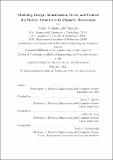Modeling, Design, Identification, Drive, and Control of a Rotary Actuator with Magnetic Restoration
Author(s)
Mohammadi Yangijeh, Sajjad
DownloadThesis PDF (16.96Mb)
Advisor
Kirtley, James L.
Lang, Jeffrey H.
Terms of use
Metadata
Show full item recordAbstract
Rotary actuators have been widely used in the industry. This thesis investigates the design, modeling, identification, drive, and control of an actuator with magnetic restoration. The design considerations are explained, FEM is used in the analysis, and a prototype is built for lab experiments. A design-oriented analytical model is developed for the actuator, in which the coil torque is obtained using the solution of Laplace’s equation in the elliptical coordinates, and the reluctance torque is derived by an approach named differential flux tubes. In addition, nonlinear and linearized electromechanical models are developed for control system designs and dynamic studies. To obtain higher accuracy, the eddy-currents in the laminations and the magnet are also modeled using an analytical solution of 1-D and 2-D diffusion equation and extracting a lumpedelement circuit for system-level analysis. It adds to the accuracy of the model to a large degree. The impact of the pre-sliding friction on the mechanical dynamic is studied as well. Then, identification of the model is performed. Next, an op-amp-based drive circuit for the current control loop is proposed, modeled, and designed. Then, three DSP-based position control techniques are implemented: pole placement with voltage drive, pole placement with current drive, and nonlinear control with feedback linearization. State observers are employed to estimate the unmeasured states. The control techniques are evaluated and compared through time response indices such as rise time, overshoot, steady-state error, and large-signal tracking, as well as by frequency domain indices like bandwidth, robustness, phase margin, sensitivity, disturbance rejection. A method of eddy-current plated is also proposed for inductance reduction. In the end, a new effectiveness index is proposed.
Date issued
2022-02Department
Massachusetts Institute of Technology. Department of Electrical Engineering and Computer SciencePublisher
Massachusetts Institute of Technology